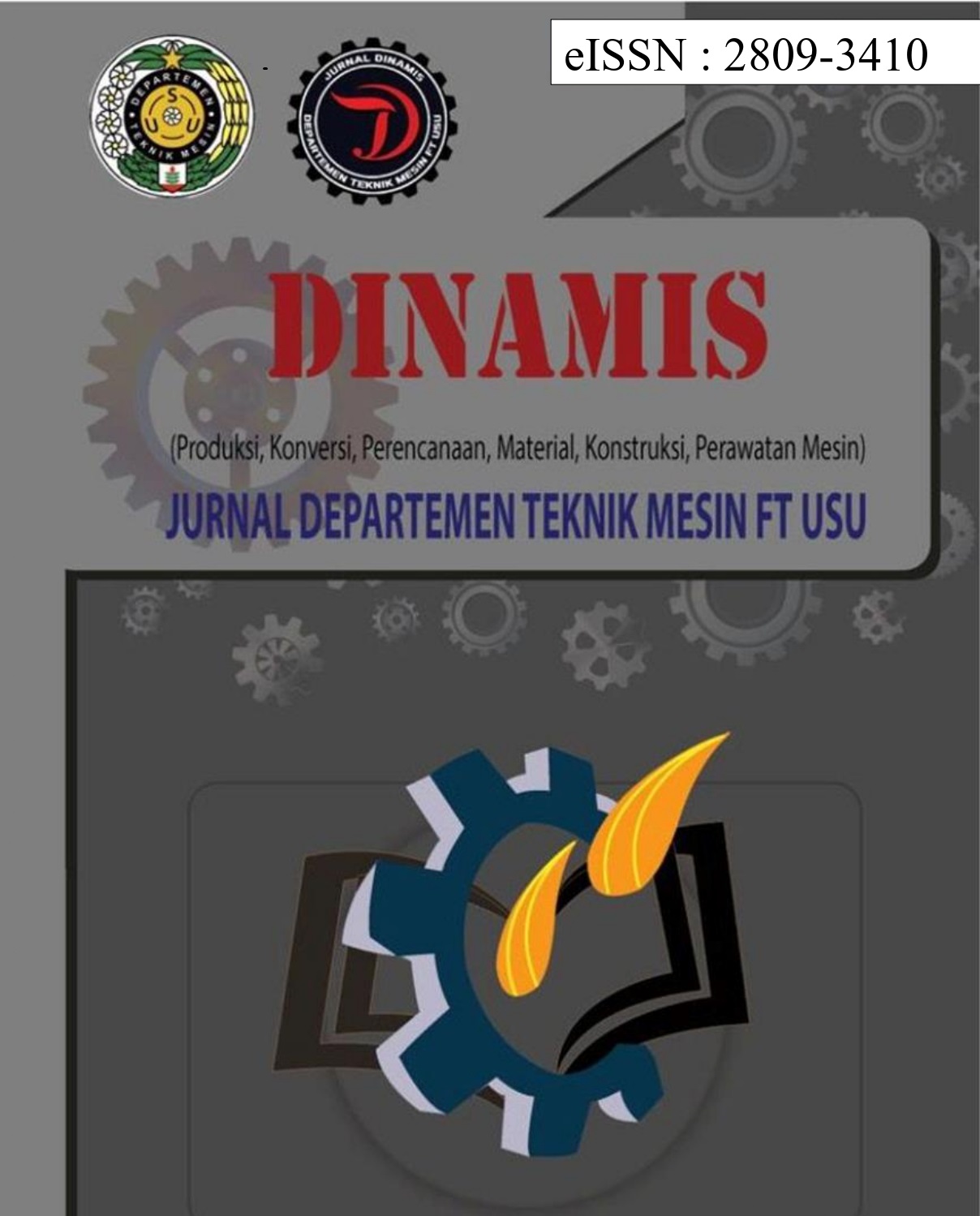Combustion Performance of Torrefied Coffee Parchment Briquettes: Effects of Particle Size and Briquetting Pressure
DOI:
https://doi.org/10.32734/dinamis.v13i1.19759Keywords:
Coffee husk briquettes, coffee skin, combustion characteristics, TorefactionAbstract
A substantial amount of coffee plantation waste is generated in Aceh highland, yet
its utilization remains limited. Most of the wastes are dumped on the ground, while
coffee parchment is often burned without further application. This study explores
the conversion of coffee parchment into briquettes, focusing on their combustion
characteristics. The parchment were subjected to torrefaction process at
temperatures ranging from 240°C to 270°C and then ground to particle sizes of 40,
60, and 80 mesh. Briquettes were formed using 10% tapioca flour as a binder and
compressed simultaneously for 20 pieces of briquettes at pressures of 300, 400,
and 500 kg/cm². The resulting briquettes, with dimensions of 37×28×28 mm,
exhibited a density of 0.63 g/cm³ and a combustion rate of 0.37 g/min, enabling a
burn duration of up to 105 minutes and a peak temperature of 435°C. The best
performance was achieved using a particle size of 60 mesh and a compaction
pressure of 400 kg/cm². These findings demonstrate the potential of coffee
parchment as a viable source of solid fuel for heating applications.
Downloads
References
Ridwansyah, "pengolahan Kopi," departemen Teknologi Pertanian , 2003.
R. M. Clarke RJ, "coffee," Elsevier applied science publishers london, vol. 1, 1985.
m. Rizanti Fadhilah Azzahra, "Produksi Bioetanol Berbahan Dasar Limbah Kulit Kopi Sebagai Bahan Bakar Alternatif," Jurnal Kinetika, vol. 12, pp. 58-63, 2021.
V. D. Pratiwi and I. Mukhaimin, "Pengaruh Suhu dan Jenis Perekat Terhadap Kualitas Biobriket dari Ampas Kopi dengan Metode Torefaksi," CHEESA: Chemical Engineering Research Articles, vol. Vol 4, pp. 39-50, 2021.
Alchalil, A. Setiawan, juwaini and t. b. nur, "Effect of densification pressure on physical and combustion properties of binderless briquettes made from rick-husk and caffee-pulp," Spinger, pp. 1-8, 2020.
A. W. Lubis, "Sifat Fisik Dan Termal Biobriket Rumput Raja Hasil Torefaksi Menggunakan Retort Kiln," in Skripsi, Lhokseumawe, Universitas malikussaleh, 2023.
S. W. Anggono, F. D. Suprianto, A. W. Kasrun and i. h. siahaan, "The Effects Of Particle Size And Pressureon The Combustion Characteristics Of Cerbera Manghasleaf Briquettes," ARPN Journal of Engineering and Applied Sciences, vol. 12, no. 1819-6608, p. 4, 2017.
V. p. Dwi, "Effect of Burning Temperature on The Quality of Alternatife Bio-energy from Coffee Waste," ELKOMIKA: Jurnal Teknik Energi Elektrik, Teknik Telekomunikasi, & Teknik Elektronika, vol. 8, no. ISSN(p) 2614-8757 | ISSN(e): 2459-9638, pp. 615-625, September 2020.
ASTM, "Test Method for Density Determination for Powder Metallurgy (P/M) Materials Containing Less Than Two Percent Porosity," AMERICAN SOCIETY FOR TESTING AND MATERIALS, 1997.
R. Manrique, D. Vasquez, C. Ceballos, F. Chejne and A. Amell, "Evaluation of the Energy Density for Burning Disaggregated and Pelletized Coffee Husks," ACS Omega, vol. 4, pp. 2957-2963, 2019.
R. Alamsyah, N. S. Chistian and F. Hasanah, "Improvement of Caloric Value of Cocopeat Biomass Pellet as Renewable Energy Fuel by Torrefaction Application," Warta IHP/Journal of Agro-based Industry, vol. 33, no. 0215-1243, pp. 17-23, 7 2016.
B. s. n. (BSN), "SNI Briket Arang Kayu Indonesia," Badan standardisasi nasional (BSN), 2000.
N. Arifin and R. Noor, "Pengaruh Komposisi Campuran Briket Arang Alang-Alang (Imperata Cylindrica) Untuk Meningkatkan Nilai Kalor," Jukung Jurnal Teknik Lingkungan, vol. 2, pp. 61-72, 2016.
T. Iskadar and U. Rofiatin, "karakteristik biochar berdasarkan jenis biomassa dan parameter proses pyrolisis," Jurnal Teknik Kimia, vol. 12, 2017.
N. Kaliyan and R. V. Morey, "Constitutive model for densification of corn stover and," ScieceDirect, vol. 104, pp. 47-63, 2009.
M. Saenger, E.-U. Hartge, J. Werther, T. Ogada and Z. Siagi, "Combustion of coffee husks," Science Direct, vol. 23, no. 1, pp. 103-121, 5 2001.
Iriany, Meliza, F. S. S. Abednego and Irvan, "Pengaruh Perbandingan Massa Eceng Gondok Dan Tempurung Kelapa Serta Kadar Perekat Tapioka Terhadap Karakteristik Briket," Jurnal Teknik Kimia USU, vol. 5, 2016.
S. Y. Kpalo, M. f. Zainuddin, L. A. Manaf and A. M. Roslan, "Evaluation of hybrid briquettes from corncob and oil palm trunk bark in a domestic cooking application for rural communities in Nigeria," Journal of Cleaner Production, vol. 284, p. 124745, 15 Februari 2021.
H. Aliah, I. Winarti, R. N. Iman, A. Setiawan, R. Safarina and A. Sawitri, "Influence of Sieve Size on Calorific Value and Proximate Properties of Bio-Briquette Composites," JEE (Jurnal Teknik Ekologi), no. ISSN 2299-8993, pp. 25-34, 24 05 2023.
G. Zhang, Y. Sun and Y. Xu, "Review of briquette binders and briquetting mechanism," Renewable and Sustainable Energy Reviews, pp. 477-478, 2018.
W. Anggono, G. J. Gotama and C. Pronk, "Characteristics of biomass briquettes from coffee husk as sustainable fuel," BIO Web of Conferences, no. 03002 , p. 62, 2023.
Qanitah, y. F. A. Dwi, Z. Ulma and y. Hananto, "Peningkatan Kualitas Briket Ampas Kopi Menggunakan Perekat Kulit Jeruk Melalui Metode Torefaksi Terbaik," Journal of Engineering Science and Technology (JESTY), vol. 1, pp. 32-43, 2023.
D. Fatmawati and P. H. Adiwibowo, "Pembuatan Biobriket Dari Campuran Enceng Gondok Dan Tempurung Kelapa Dengan Perekat Tetes Tebu," Jurusan teknik mesin, vol. 03, pp. 315-322, 2014.
S. munir, "peran sistem klasifikasi bahan bakar padat konvensional hubunganya dengan diversikasi energi," vol. 1, pp. 69-78, 2008.
Additional Files
Published
How to Cite
Issue
Section
License
Copyright (c) 2025 DINAMIS

This work is licensed under a Creative Commons Attribution-ShareAlike 4.0 International License.






